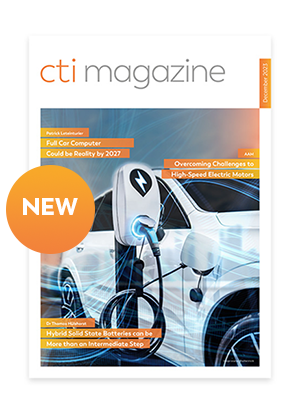More stringent world-wide government regulations addressing the reduction of poor air quality across many cities and noise pollution whilst increasing road safety are driving the Automotive Industry manufacturers to focus R&D efforts on more efficient and accurate overall powertrain control.
Johannes Gießibl, Senior Magnetoelastic Project Manager, Methode Electronics International GmbH
Download CTI Mag to read full article
Issue: #December 2017
According to the Advanced Combustion and Emission Control Technical Team (ACEC), which is one of 12 U.S. DRIVE technical teams whose mission is to accelerate the development of pre-competitive and innovative technologies to enable a full range of efficient and clean advanced light-duty vehicles, as well as related energy infrastructure, Engine efficiency improvement can be achieved by the application of technologies to a system (engine or after treatment) to reduce the fuel consumption, improve the torque, or improve reduction of a pollutant.
Efficiency improvement is measured at a specific test condition or multiple test conditions. For an engine, efficiency is measured at specific speed and torque. This is reported using measures such as brake thermal efficiency or brake specific fuel consumption. Firstly, the efficiency of the component is improved and studied at specific test conditions. Secondly, the improved component is integrated into a specific vehicle, optimized for the vehicle application and the system is then tested on a drive cycle. Many vehicle specific assumptions including vehicle size, aerodynamics, transmission, tires, drive schedule and control system are required for a fuel economy test.1 A poor integration or technology mismatch for the vehicle application may lead to little or no fuel economy improvement, despite the improved component and unless new proven technologies for measuring real-time torque are introduced, the need for complex control algorithms, test evaluations, and subsequent qualification that are currently required for monitoring the efficiency of electronically controlled vehicle transmission will remain a time consuming reality for Vehicle Manufacturers and professionals in the field.
New combustion concepts such as LTC (Low Temperature Combustion), PPC (Partially Premixed Combustion) or HCCI (Homogeneous Charge Compression Ignition) are determining a demand for dynamic feedback control. A real-time torque sensor allows combustion balancing within each operational mode, assists in managing mode shifts between different combustion sequences, and for each combustion cycle, provides feedback of combustion efficiency at both steady state and transient operation. By monitoring the torque characteristic before and after refueling fuel quality differences can be identified and used to avoid potential warranty claims.

Diagnostic functions associated with automotive engines involve near periodic processes due to the nature of multi-cylinder engines. The real-time torque sensor exploits the inherent periodicity of the combustion to obtain a mean torque produced by each cylinder during each stroke (Figure 1). Not only is the overall torque measured but for the first time subtle changes in the torque created by each cylinder is directly measureable. This is quite a useful property for torque balancing DI engines with an aim to eliminate vibration and decrease the level of emissions caused by disturbances such as variability in injector efficiency, inertia, and the geometry between cylinders. It is also useful for detecting cylinders that produce variable torque outputs or exhibit signs of misfire (Figure 2) or knock, suggesting that the realtime torque sensor can be a good indicator of engine abnormalities.

Methode’s industry proven dynamic real-time torque sensor has been in series production in OEM applications since 2008, while an innovative patented technology with a sensor mounted in a transmission configuration is currently conducting in-vehicle trials and has up till now surpassed 480,000 miles of use without failure or change to its performance. This technology has immeasurable proven potentials:
- Reduces gear change times down to a minimum through the reduction of signal bandwidth, resulting to gear changes twice as fast as current hydraulic auto transmissions;
- Monitors the shift quality between different drive modes controlling the shift performance, due to its accurate measurement properties of the total output of the system;
- Supports a wider spread of gear ratios facilitating engine downsizing and cylinder reduction, and
- The possibility of adding more gears means that the engine RPM can be optimized to the load, thereby saving fuel.
